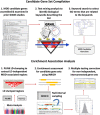Multi-locus genome-wide association analysis supports the role of glutamatergic synaptic transmission in the etiology of major depressive disorder
- PMID: 23149448
- PMCID: PMC3565768
- DOI: 10.1038/tp.2012.95
Multi-locus genome-wide association analysis supports the role of glutamatergic synaptic transmission in the etiology of major depressive disorder
Abstract
Major depressive disorder (MDD) is a common psychiatric illness characterized by low mood and loss of interest in pleasurable activities. Despite years of effort, recent genome-wide association studies (GWAS) have identified few susceptibility variants or genes that are robustly associated with MDD. Standard single-SNP (single nucleotide polymorphism)-based GWAS analysis typically has limited power to deal with the extensive heterogeneity and substantial polygenic contribution of individually weak genetic effects underlying the pathogenesis of MDD. Here, we report an alternative, gene-set-based association analysis of MDD in an effort to identify groups of biologically related genetic variants that are involved in the same molecular function or cellular processes and exhibit a significant level of aggregated association with MDD. In particular, we used a text-mining-based data analysis to prioritize candidate gene sets implicated in MDD and conducted a multi-locus association analysis to look for enriched signals of nominally associated MDD susceptibility loci within each of the gene sets. Our primary analysis is based on the meta-analysis of three large MDD GWAS data sets (total N=4346 cases and 4430 controls). After correction for multiple testing, we found that genes involved in glutamatergic synaptic neurotransmission were significantly associated with MDD (set-based association P=6.9 × 10(-4)). This result is consistent with previous studies that support a role of the glutamatergic system in synaptic plasticity and MDD and support the potential utility of targeting glutamatergic neurotransmission in the treatment of MDD.
Figures

References
-
- Hasin DS, Goodwin RD, Stinson FS, Grant BF. Epidemiology of major depressive disorder: results from the National Epidemiologic Survey on Alcoholism and Related Conditions. Arch Gen Psychiatry. 2005;62:1097–1106. - PubMed
-
- Muglia P, Tozzi F, Galwey NW, Francks C, Upmanyu R, Kong XQ, et al. Genome-wide association study of recurrent major depressive disorder in two European case-control cohorts. Mol Psychaitry. 2010;15:589–601. - PubMed
-
- Breen G, Webb BT, Butler AW, van den Oord EJ, Tozzi F, Craddock N, et al. A genome-wide significant linkage for severe depression on chromosome 3: the depression network study. Am J Psychiatry. 2011;168:840–847. - PubMed
Publication types
MeSH terms
Substances
Grants and funding
- R01 MH066206/MH/NIMH NIH HHS/United States
- AA13320/AA/NIAAA NIH HHS/United States
- R01 MH-072802/MH/NIMH NIH HHS/United States
- R01 AA013321/AA/NIAAA NIH HHS/United States
- N01 MH-90003/MH/NIMH NIH HHS/United States
- MH-094614/MH/NIMH NIH HHS/United States
- R01 MH086026/MH/NIMH NIH HHS/United States
- NIMH MH086026/PHS HHS/United States
- AA14041/AA/NIAAA NIH HHS/United States
- N01 MH090003/MH/NIMH NIH HHS/United States
- AA13326/AA/NIAAA NIH HHS/United States
- R01 AA013320/AA/NIAAA NIH HHS/United States
- R01 AA007535/AA/NIAAA NIH HHS/United States
- R01 MH072802/MH/NIMH NIH HHS/United States
- K24 MH094614/MH/NIMH NIH HHS/United States
- R01 AA014041/AA/NIAAA NIH HHS/United States
- K05 AA017688/AA/NIAAA NIH HHS/United States
- AA13321/AA/NIAAA NIH HHS/United States
- AA10248/AA/NIAAA NIH HHS/United States
- R01 AA013326/AA/NIAAA NIH HHS/United States
- MH66206/MH/NIMH NIH HHS/United States
- R01 MH079799/MH/NIMH NIH HHS/United States
- MH-079799/MH/NIMH NIH HHS/United States
LinkOut - more resources
Full Text Sources

